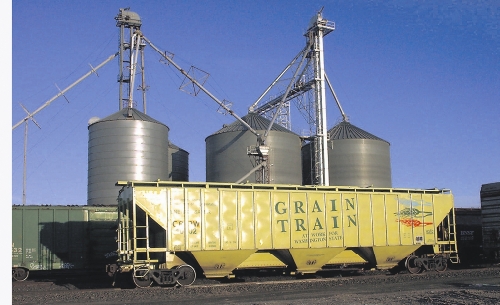the film
forum
library
tutorial
contact
|

|
Tour Highlights Important Role Dams Play in
Moving Commodities by Water in the Pacific Northwest
by National Association of Wheat Growers
AgInfo.net, June 22, 2021
|
 From the very first settlers to now, dams and waterways have played a very important role in moving commodities like wheat grown in Montana to export facilities in the Pacific Northwest.
From the very first settlers to now, dams and waterways have played a very important role in moving commodities like wheat grown in Montana to export facilities in the Pacific Northwest.
In fact, each year about 14 million metric tons of wheat destined for export move through the Columbia-Snake system. To highlight the importance of this and the consequences of breaching the four lower Snake River dams would have on the agriculture community, a tour was held this past week to provide attendees a first-hand experience of this essential transportation system.
"We were very fortunate to be invited out by the Idaho Grain Producers Association and Idaho Farm Bureau to look at the importance of the navigation system of the Columbia-Snake River and the efficiencies that it brings to the commodity markets, especially for wheat" said Chandler Goule, National Association of Wheat Growers CEO. "During a time when everything is all about sustainability, we looked at how efficient barges are compared to additional rail or trucks being put on the highways."
He says, exports are critical to U.S. wheat growers, and maintaining these locks and dams plays a vital role in ensuring our competitiveness, providing a safe and reliable mode of transportation, and are essential to the long-term viability of our industry throughout the region.
"These dams provide such a benefit and economic stimulus to this area that breaching those dams is going to be to be devastating not only to the fish population, but to Rural America and the agricultural communities in that area all the way to the West Coast" said Goule.
Over 60% of the cargo that moves on the Columbia Snake River System is high-quality U.S. wheat grown in our region and exported overseas. In fact, nearly 10% of all U.S. wheat exports travel by barge on the Snake River each year.
The National Association of Wheat Growers says without barging, over 38,000 rail cars or over 149,000 semi-trucks would be needed to move the cargo that was moved over the river in 2018.
(bluefish does the math: Assuming 110 rail cars on one train, 38,000 rail cars would amount to one more train per day.)
National Association of Wheat Growers
Tour Highlights Important Role Dams Play in Moving Commodities by Water in the Pacific Northwest <-- Listen at Original site.
AgInfo.net, June 22, 2021
See what you can learn
learn more on topics covered in the film
see the video
read the script
learn the songs
discussion forum


 From the very first settlers to now, dams and waterways have played a very important role in moving commodities like wheat grown in Montana to export facilities in the Pacific Northwest.
From the very first settlers to now, dams and waterways have played a very important role in moving commodities like wheat grown in Montana to export facilities in the Pacific Northwest.
